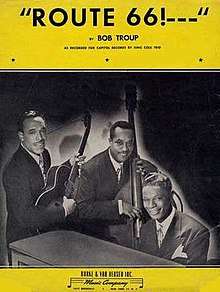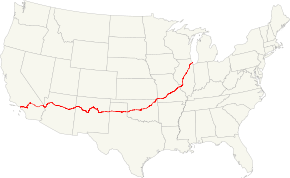Route 66 (song)
| "(Get Your Kicks on) Route 66" | |
|---|---|
 Sheet music cover featuring the King Cole Trio | |
| Single by the King Cole Trio | |
| B-side | "Everyone Is Sayin' Hello Again (Why Must We Say Goodbye)" |
| Released | 1946 |
| Format | Ten-inch 78 rpm record |
| Genre | Rhythm and blues |
| Length | 2:57 |
| Label | Capitol (256) |
| Songwriter(s) | Bobby Troup |
"(Get Your Kicks on) Route 66" is a popular rhythm and blues standard, composed in 1946 by American songwriter Bobby Troup. The song uses a twelve-bar blues arrangement and the lyrics follow the path of U.S. Route 66 (US 66), which traversed the western two-thirds of the U.S. from Chicago, Illinois, to Los Angeles, California.
Nat King Cole, as the King Cole Trio, first recorded the song the same year and it became a hit, appearing on Billboard magazine's R&B and pop charts.[1]
Another version to reach the Billboard charts was that recorded by Bing Crosby with the Andrews Sisters on May 11, 1946[2] and this reached the No. 14 position in 1946.[3] The song was subsequently recorded by many artists including Chuck Berry, Glenn Frey, the Rolling Stones, Them, Dr. Feelgood, Asleep at the Wheel, the Manhattan Transfer, Depeche Mode, The Brian Setzer Orchestra, Pappo, The Cramps, John Mayer,[4], George Benson and Peter Tork & Blue Suede Shoes.
Composition and lyrics
Bobby Troup got the idea for the song on a cross-country drive from Pennsylvania to California. Troup wanted to try his hand as a Hollywood songwriter, so he and his wife, Cynthia, packed up their 1941 Buick and headed west. The trip began on US 40 and continued along US 66 to the California coast. Troup initially considered writing a tune about US 40, but Cynthia suggested the title "Get Your Kicks on Route 66". The song was composed on the ten-day journey, and completed by referencing maps when the couple arrived in Los Angeles.[5]
The lyrics read as a mini-travelogue about the major stops along the route, listing several cities and towns through which Route 66 passes, viz. St Louis; Joplin, Missouri; Oklahoma City, Oklahoma; Amarillo, Texas; Gallup, New Mexico; Flagstaff, Arizona; Winona, Arizona; Kingman, Arizona; Barstow, California; and San Bernardino, California. Winona is the only town out of sequence: it was a very small settlement east of Flagstaff, and might indeed have been forgotten if not for the lyric "Don't forget Winona", written to rhyme with "Flagstaff, Arizona". Many artists who have covered the tune over the years have changed the initial lyrics, usually to "It goes to St. Louis, down through Missouri..." then continuing on with Oklahoma City and so on. Of the eight states through which the actual route passes, only Kansas and its cities—US 66 spends just eleven miles (18 km) inside the state’s southeast corner—are not mentioned by the song. Chuck Berry famously mispronounces Barstow to rhyme with "cow" instead of correctly pronouncing it to rhyme with "go".
"Route 66" was first recorded in 1946 by Nat King Cole,[6] whose rendition became a hit on both the U.S. R&B and pop record charts.[1] Cole later re-recorded the tune in 1956 (for the album After Midnight) and 1961 (The Nat King Cole Story).
Other recorded versions

The song has become a standard and has been recorded by numerous artists.[4] The version recorded by Perry Como in 1959 (on the album Como Swings) is more lyrically complete, including the seldom-heard second verse and also the introductory verse. Chuck Berry's version was closest to its R&B roots, with jazz overtones, often blended into his songs by Berry.
- Two of the leading British Invasion bands included "Route 66" on their debut albums, Them (Featuring Van Morrison) and the Rolling Stones.
- Michael Martin Murphey covered the song on his 1989 album Land of Enchantment. His version was released as a single in 1990 and peaked at number 67 on the Billboard Hot Country Singles & Tracks chart.[7] Little Willie Littlefield recorded a boogie-woogie version for his 1997 album The Red One.
- Essex-born English singer-songwriter Billy Bragg recorded an anglicised version of the song called "A13 (Trunk Road to the Sea)" for a John Peel session in 1985. In the song—strummed and sung to the same tune as the original — the landmark cities are replaced with English towns along the route of the A13, with Bragg inviting listeners to "Go motoring, on the A-thirteen". According to Bragg he wrote the lyrics whilst playing with his band Riff Raff in 1977: whilst the band played "Route 66" as part of their set, Bragg "objected to singing about these places that (he) didn't know... there's a tradition of driving down the A13 to the glory of Southend. Growing up in Barking, that was the promised land, in quite a Springsteenish way". The song was originally meant to be released on Bragg's 1983 debut album Life's a Riot with Spy vs Spy, however it was ultimately not included due to problems getting permission to use the music of "Route 66". It was finally released commercially on the bonus disc of the 2003 compilation Must I Paint You a Picture? The Essential Billy Bragg.[8]
In popular culture
Natalie Cole's version of the song was one of many California-related songs played throughout "Sunshine Plaza" in the original Disney California Adventure.[9]
The song is also played in the 2006 Pixar film Cars and is sung at the end of the film RV, which was released the same year.
References
- 1 2 Whitburn, Joel (1988). Top R&B Singles 1942–1988. Record Research, Inc. p. 94. ISBN 0-89820-068-7.
- ↑ "A Bing Crosby Discography". BING magazine. International Club Crosby. Retrieved September 20, 2016.
- ↑ Whitburn, Joel (1986). Joel Whitburn's Pop Memories 1890-1954. Wisconsin, USA: Record Research Inc. p. 113. ISBN 0-89820-083-0.
- 1 2 Unterberger, Richie. "The Rolling Stones: Route 66 – Song Review". AllMusic. Rovi Corp. Retrieved March 27, 2015.
- ↑ Kelly, Susan Croce (1990). Route 66: The Highway and Its People. University of Oklahoma Press. pp. 148–149. ISBN 978-0806122915.
- ↑ Gilliland, John (1969). "Show 22 - Smack Dab in the Middle on Route 66: A skinny dip in the easy listening mainstream. [Part 1]" (audio). Pop Chronicles. University of North Texas Libraries. Track 4.
- ↑ Whitburn, Joel (2013). Hot Country Songs 1944–2012. Record Research, Inc. p. 234. ISBN 978-0-89820-203-8.
- ↑ de Lisle, Tim (25 August 2006). "Drive-time blues". theguardian.com. Retrieved 28 July 2017.
- ↑ "Songs from Sunshine Plaza Area". parktunes.com. Retrieved October 14, 2017.